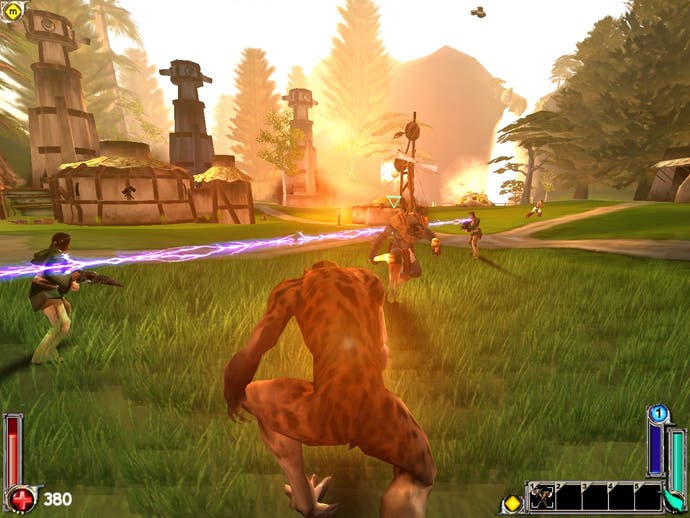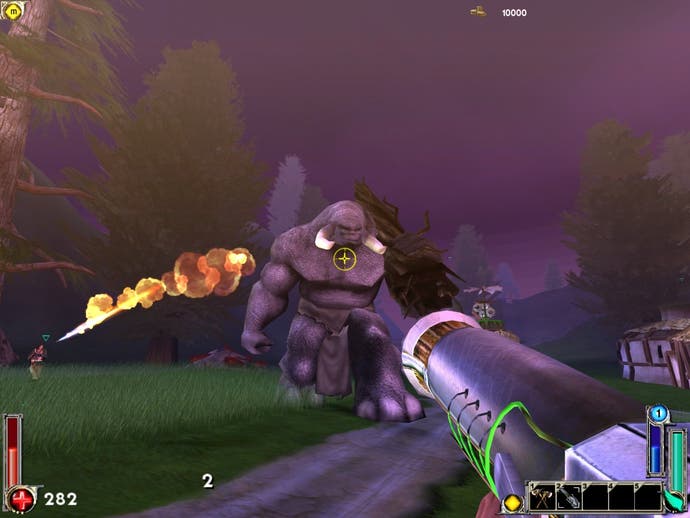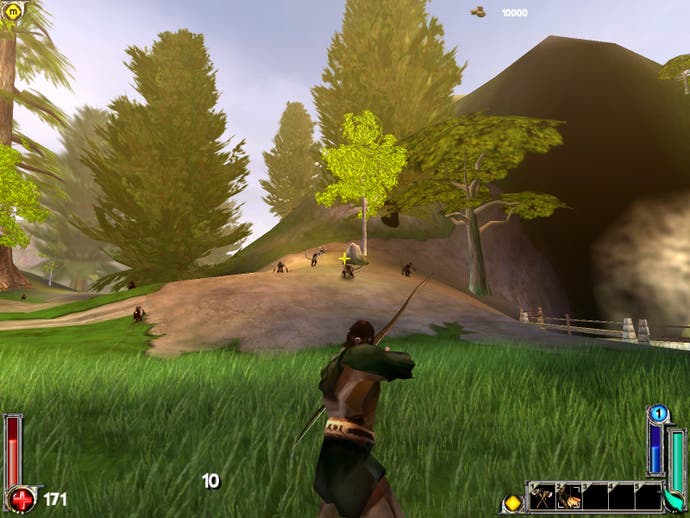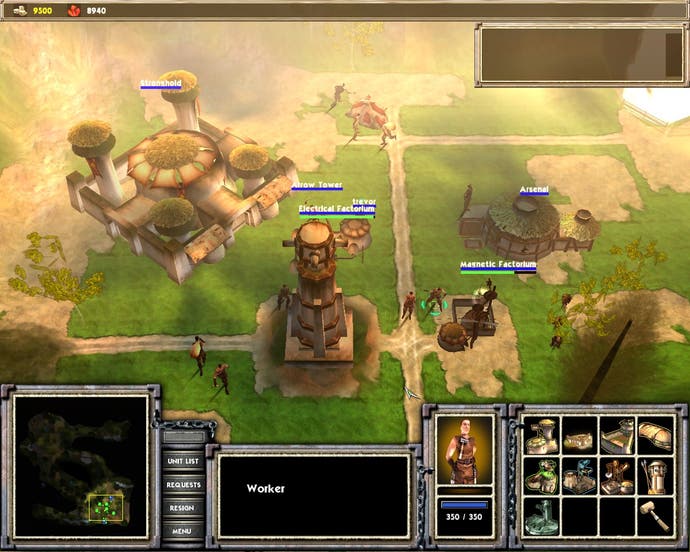Savage: The Battle for Newerth
A real-time strategy shooter. Curious beast!
Playing Savage brings to mind an old Super Play column called Daydreaming, in which readers submitted ideas for games and the best one each month received a prize. This is exactly the sort of idea people pitched: a strategic and fantastical war game hooked into an evolutionary colour clash - a post-apocalyptic struggle between technologically resurgent man and magical beast - where you can play everything from grunt to general, the nature your involvement and military discipline left entirely to your own discretion. A strictly multiplayer affair, Savage is hard to get into and eventually divides opinion anyway, but in the company of organised savages, it's an incomparably absorbing experience amongst a recent slew of pretty but vacuous shooters. It's the sort of game you dream about.
Above and below

It's also the sort of game you have to invest in to truly enjoy, particularly if you aspire to more than just scampering around the lush plains of Newerth waving an axe, and have an eye to command from on high. See, Savage is a real genre-bender. At face value, S2 Games' oddity is a good-looking team-based WASD shooter with a third-person melee element a bit like Jedi Knight's, in which two teams of 30 or more Humans or Beasts spend about an hour fostering a stronghold on a massive map, whilst simultaneously trying to destroy their opponents'. But while the ranks of entry-level warriors repeatedly trudge from spawn to battle, giving their lives each time to further inconvenience the enemy and gather territory, one bloke on each side is busy sizing up the battle from above, playing a real-time strategy game with human-controlled units.
And yes, that does involve mining for gold and resources using up to ten NPC peon units (with optional help from the grunts), positioning and building new structures, choosing which new weapons technologies to research (of either the science fictionalised or magical variety, depending on race), and paying for mobile sensors and any funding requests from the troops on the ground, who keep respawning as the same boring default class and need a few extra quid to begin life with thicker skin. Commanding also involves figuring out what the enemy is up to and reacting by issuing orders to the troops in the thick of things.
Most of the time though, you'll be the one on the receiving end of orders, and sometimes they can seem baffling, not to mention boring. Escort another gamer's lumbering siege weapon so it can take pot shots at enemies from afar? Move to a waypoint way across the map when I'm quite busy building up experience by slaughtering the local fauna? There are more things going on in Joe Grunt's momentary existence than slashing alone, so it's up to the RTSing Commander to keep him happy, approving his funding requests, tossing him monetary scraps every now and then and even promoting him when he plays ball. If he proves himself competent, he'll fight better with more expensive weapons, and be more inclined to continue following your orders. And so the lines are drawn and the war rages.
Hardly a war in the park

It's a fabulous concept, isn't it? It's a slow burner though. There's so much going on at first that it'll take hours of careful study and hard earned combat smarts before you truly influence the outcome of a substantial gathering. What are all these icons on the map? What do all these buildings do? Which ones should I protect? What are these bloody voices in my head? Those are just your initial worries. Tooled up with a chunky manual's worth of theory, your first few rounds are still a baptism of fire until you gather some experience and buy some proper tools from your team's stronghold or the nearest sub-lair. Even then you may find the endless trudging around tedious, and the often-fleeting skirmishes that result both tough and somewhat lethargic.
Although some of the better projectile weapons are pretty direct, most of them are a bit slow with limited ammo, and some of these units have massive health stats, so it'll take a while before you're confident enough to lead a target at distance and brandish the weightier attacks effectively, thanks largely to a combination of predominantly open map design and your opponent's dash key. That, and enemy magic or long distance weapons raining fire and brimstone down upon you. Closer up it's a third-person click-for-all as enemies circle each other erratically, swinging as precisely as possible to try and click each other to death. Although I'm by no means accomplished at this even now, I'm getting better, and it must come eventually because there are plenty of people doing it convincingly in every game I join. Practise obviously reaps rewards - few finer than picking off an enemy with a well-aimed lightning bolt - but then that's little comfort when the next guy spawns as an elephantine super beast and tramples away from you with an uprooted tree slung casually over his shoulder as a club, his every footstep jarring your view of the action. When do I get to do that?
Combat proficiency is key to advancement, and it's definitely an area that could do with proper documentation, so it's a bit disappointing to find no tutorial (or offline mode of any kind) included in the retail version, even after a lengthy delay prior to its release in Europe. One benefit of the game's extended incubation period has been the addition of a 64-page strategy guide to the package, but it's difficult to see this having a significant impact on your initial combat skills whatever its contents (and they didn't send me one, sadly). Fortunately though, S2 Games is a small developer which has gathered a loyal following, most of whom will be happy to help you out either on the boards or in game if you're having trouble finding your feet. The class/weapon/item select screen (which determines your load-out prior to each spawn) has a larger chat window, and the last few lines are always visible in the game, so it's easy to seek advice even on the front lines. There is the danger you'll encounter a few unsympathetic wasters more interested in heckling than helping, but the odds are no worse than anywhere else on the Internet.
Human nature

When you do get to grips with Savage, it's a totally different game. If you have a handful of gaming pals with similar tastes, or better yet you're in a half-decent clan, turn them onto it at the same time as you, get organised and take on some of the public server crowds, find some equally organised opponents or head off to a LAN party. If the logistics of such operations are beyond your motley band, then you'll be pleased to learn there are usually enough people online for a decent sized game, with the crowds set to increase following the game's European debut, and even with complete strangers you sometimes fall into exactly the right mix - like I did earlier today as a noble human repelling wave after wave of beast incursions in a slightly lop-sided gathering, occasionally pilfering enough dinero to buy myself a catapult. With enough people, Savage truly is strategic team-based multiplayer on an unprecedented scale. You will still spend plenty of time darting between base and battle whatever your skill level or chosen character class that round (unless your healers are particularly well protected), but as a team you'll also fight shoulder-to-shoulder defending your sub-lairs, and work together overrunning the enemy's, with each loss or gain felt up and down the chain from the man in the sky to the face in the dirt.
Savage has roles for everyone - the twitch kill prodigy with solid projectile skills, the keyboard gymnast with a taste for hand-to-hand combat, the flatmates who like to gang up on stragglers beneath a canopy of lush vegetation, the room full of networked gamers yelling positions to each other, and even the quick-witted armchair general. But it is a game that lives or dies based on who's playing it. This sort of freedom breeds unpredictability, and from time to time as a general you'll be annoyed by the inaction, incompetence and insubordination of your supposed underlings, whilst on the ground you'll sometimes feel disconnected from your team-mates, frustrated by the endless respawn cycle, or disappointed by a lack of intuition from your comrades, particularly if it's the man upstairs. Join a clan, play it properly, and it's gold dust. Pick it up hoping to dive onto a public server every night though, and you'll strike out more often than not. It is a game that's only at its best when everyone's on the same wavelength.
The guts of the beast

That is the nature of the design though, and under the right circumstances it's a risk worth taking. Sure, there are too many wannabe chiefs and not enough braves, and it's a game that's only ever going to satisfy a small minority of gamers, but if you are one of those people then you could play it for months on end. S2 isn't a big developer, and publisher Digital Jesters doesn't have bottomless pockets, so there are still a lot of outstanding issues unresolved by the small dev team, like the sight of catapults floating and clipping awkwardly as they climb ramps, but at least they're being dealt with steadily and in order of severity, and the developer has still managed to be very active in supporting the game with content updates. On top of that, the European Savage will ship with an inventory of community creations and an official "Samurai Wars" mod (sadly unfinished at the time of review) on a bonus disc, which should keep you going even longer.
Technically speaking Savage is an impressive accomplishment too. Although it's undoubtedly going to stress lower end machines with its vast draw distances, swaying fields of long-grass and huge numbers of intricately detailed units, there are options to turn things off until it suits. Viewed at its best though, it's surprisingly good looking considering how small the dev team was, how epic the scope of the game was, and how many things are going on at once on-screen. If the sight of a beast horde rampaging through a garrison, gigantic tree trunk-swinging elephant monsters at the front and sulphur and electricity raining from the heavens, buildings exploding under the strain and bodies piled everywhere doesn't elicit some form of reaction, then there's no hope for you. The soundtrack too continually rouses the player, latching onto larger conflicts and adding a flavour of grandiosity to proceedings, while the sound effects are suitably medieval and, dare I say it, savage. (That is, if you can hear them - one of the outstanding bugs means that Santa Cruz chipset soundcard owners have to employ a workaround, turning audio hardware acceleration down a couple of notches to compensate. Don't worry though; it's on S2's bug list.)
Primordial
In an industry driven largely by the obvious, the uninspired and the bankable sequel, there's a growing tendency amongst critics to latch onto new ideas and blow them out of all proportion, so it's important for us to accept that while Savage may be refreshing, it is also flawed. Like a lot of games, there is the temptation to mark it down because it doesn't service enough of the people enough of the time. But herein lies the key difference: while it's fair to level some criticism at the lack of tutelage, and the combat is a bit divisive and unforgiving to begin with, you can't really blame the developer for Savage's biggest problem - the way it's played online. Given the right people and the right attitude, this is one of the finest multiplayer games of the year so far. If you can give it that, then you should give it a go.
Savage: The Battle for Newerth (PC) is due out in the UK on February 27th, and throughout the rest of Europe during March and April. You can download a demo of the game here.

